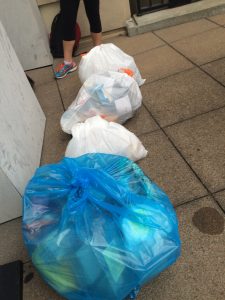
Pictured above are the four bags of trash assigned to our group. The blue bag was filled with recycling, two of the white bags were filled with kitchen and food refuse, and the third white bag contained paper and office materials.
While our group was given four bags of trash, we ended up only using three of the bags due to time constraints. The first bag we opened and sorted was the blue bag, which was filled with large artifacts, all of which were recyclables. The bag itself was larger than the rest and also had a logo on it that showed it was from a local recycling company. There was another bag filled with recyclable materials but those consisted of papers and mail rather than containers. Two of the bags were filled with rubbish from the kitchen so our group only used one of them.
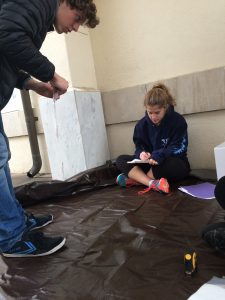
Pictured above are two of my group mates, Annie and Aleksander. Annie is filling out the artifact form while Aleksander is describing and bagging an artifact.
In order to work as efficiently as possible our group split up, with some of us downstairs in the lab working on sorting and more thoroughly documenting the artifacts and some of us outside sorting the trash and documenting the different items. Those of us outside all worked together when first opening a bag to roughly sort items into different categories to make sure every item was properly documented. We then split into two teams, each with one person filling out the artifact document and writing down details and another bagging the artifacts and calling out descriptions. This method helped us quickly and effeciently document the 250 artifacts.
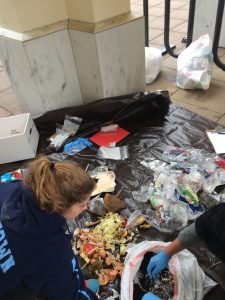
Pictured above is our group in the midst of sorting through the bag that had the food and kitchen waste.
The most challenging bag to sort through was the bag that had the perishable food waste. The coffee grounds infiltrated everything and had a very distinct smell. This bag also contributed a major portion of all of the artifacts and had the most unique items out of all of the bags. Aside from the food waste, the rubbish consisted of Valentine’s Day candy wrappers, food packaging, and some miscellaneous items. The food packaging ranged from sandwich baggies to grocery bags to wine corks. One of the most interesting items we discovered was a harmonica, which may be functional. The food waste included vegetable peels from garlic, onions, cucumbers, white asparagus, whole wheat bread, and coffee grounds. Looking at the amount of food waste and the type of things thrown away helped our group analyze the socioeconomic status of the family.
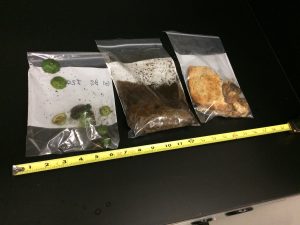
Pictured above are three of the artifacts that were disposed shortly after due them being perishable items. The measuring tape is to provide scale for the different items, which include what seem to be cucumber tips, coffee grinds, and wheat bread.
Once all of the artifacts were bagged and properly documented our group started categorizing all of them. Since the perishable items could not be kept for two weeks we took pictures to refer to when doing our research. After taking the pictures these artifacts were thrown away. The picture was taken in the lab and is one of the many steps our group took when sorting the artifacts in order to obtain as much information as possible. The measuring tape is present in the image in order to help us put things in scale. However, we relied on weight as the measurement for perishables and items that were not very symmetrical.
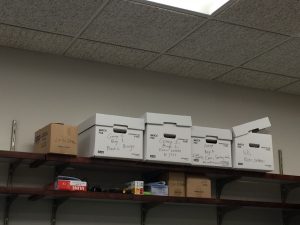
Pictured above are the boxes in which our group stored the artifacts. Each box has a description so it would be easier for us to find a specific artifact when needed.
This image shows the boxes we used to hold our artifacts stacked on the shelves of the lab room. We decided to split up the artifacts based on considerations like which bag it came from and what kind of material it was (i.e. plastic, glass, papers) and the context (i.e. Valentine’s Day, mail). The artifact documents were sorted under the same categories but with many more subcategories so it would be easier to locate a specific artifact’s description if needed. For example, when our group was working on an outline for our research paper, there was a dispute on whether or not the lyrics to a religious song found was for a Christian choir. We immediately looked to the binder of documents and also the box labeled for paper trash and found both quite easily.